Attached files
| file | filename |
|---|---|
| 8-K - FORM 8-K - PNC FINANCIAL SERVICES GROUP, INC. | d818004d8k.htm |
 Exhibit 99.1
The PNC Financial Services Group, Inc.
BancAnalysts Association of Boston
November 6, 2014 |
 Cautionary
Statement Regarding Forward-Looking Information and Adjusted Information
2
Our presentation includes “snapshot” information about PNC used by way of
illustration. It is not intended as a full business or financial review and should be
viewed in the context of all of the information made available by PNC in its SEC filings. The presentation also contains forward-looking
statements regarding our outlook for earnings, revenues, expenses, capital and liquidity
levels and ratios, asset levels, asset quality, financial position, and other matters
regarding or affecting PNC and its future business and operations. Forward-looking statements are necessarily subject
to numerous assumptions, risks and uncertainties, which change over time. The
forward-looking statements in this presentation are qualified by the factors
affecting forward-looking statements identified in the more detailed Cautionary Statement included in the Appendix, which is included
in the version of the presentation materials posted on our corporate website at
www.pnc.com/investorevents, and in our SEC filings. We provide greater detail regarding
these as well as other factors in our 2013 Form 10-K and our 2014 Form 10-Qs, including in the Risk Factors and Risk
Management sections and in the Legal Proceedings and Commitments and Guarantees Notes of the
Notes To Consolidated Financial Statements in those reports, and in our subsequent SEC
filings. Our forward-looking statements may also be subject to other risks and uncertainties, including
those we may discuss in this presentation or in our SEC filings, accessible on the SEC’s
website at www.sec.gov and on PNC’s corporate website at www.pnc.com/secfilings. We
have included web addresses in this presentation as inactive textual references only. Information on those websites
is not part of this presentation. Future events or circumstances may change our outlook and
may also affect the nature of the assumptions, risks and uncertainties to which our
forward-looking statements are subject. Forward-looking statements in this presentation speak only as of the date
of this presentation. We do not assume any duty and do not undertake to update those
statements. Actual results or future events could differ, possibly materially, from
those anticipated in forward-looking statements, as well as from historical performance.
In this presentation, we may sometimes refer to adjusted results to help illustrate the impact
of certain types of items, such as benefits/provisions for residential mortgage
repurchase obligations and gain related to BlackRock’s 2009 acquisition of Barclay Global Investors. This information
supplements our results as reported in accordance with GAAP and should not be viewed in
isolation from, or as a substitute for, our GAAP results. We believe that this
additional information and the reconciliations we provide may be useful to investors, analysts, regulators and others to help
evaluate the impact of these respective items on our operations. We may also provide
information on the components of total net interest income (purchase accounting
accretion and the remainder, which we refer to as core net interest income), on the impact of purchase accounting accretion
on net interest margin (core net interest margin being net interest margin less (annualized
purchase accounting accretion divided by average interest-earning assets)), on
pretax pre-provision earnings (total revenue less noninterest expense), and on tangible book value per common
share (calculated based on tangible common shareholders’ equity (common
shareholders’ equity less goodwill and other intangible assets, other than
servicing rights, net of deferred tax liabilities on such intangible assets) divided by period-end common shares outstanding). Where
applicable, we provide GAAP reconciliations for such additional information, including in the
slides, the Appendix and/or other slides and materials on our corporate website at
www.pnc.com/investorevents and in our SEC filings. In certain discussions, we may also provide information on yields
and margins for all interest-earning assets calculated using net interest income on a
taxable-equivalent basis by increasing the interest income earned on tax-exempt
assets to make it fully equivalent to interest income earned on taxable investments. We believe this adjustment may be
useful when comparing yields and margins for all earning assets. We may also use annualized,
pro forma, estimated or third party numbers for illustrative or comparative purposes
only. These may not reflect actual results. This presentation may also include discussion of other non-GAAP financial measures, which,
to the extent not so qualified therein or in the Appendix, is qualified by GAAP
reconciliation information available on our corporate website at www.pnc.com under “About PNC–Investor
Relations,” which may include materials from other investor presentations or in our
annual, quarterly or current reports. |
 Agenda
PNC overview
Strong financial performance in challenging revenue
environment
Executing on our strategic priorities
Achieving expense management and capital
deployment objectives
3 |
 Corporate &
Institutional A leader in serving middle-market,
large corporate, government and
non-profit entities
A top 10 U.S. bank-held wealth
manager
Asset Management
Residential Mortgage
A primary consumer product
National distribution capabilities
(1) Rankings source: SNL DataSource; Holding companies (for assets) or Banks (for deposits,
branches and ATMs) headquartered in U.S. Assets rank excludes Morgan Stanley and
Goldman Sachs. Both Residential Mortgage Banking and Corporate
& Institutional Banking offices located in these states.
CO
TX
KS
BlackRock
A leader in investment management, risk
management and advisory services
worldwide
September 30, 2014
U.S. Rank
(1)
Deposits
$226B
7
th
Assets
$334B
7
th
Branches
2,691
4
th
ATMs
8,178
3
rd
Footprint covering nearly half of the U.S.
population
Retail Banking
PNC’s Leading Franchise
4 |
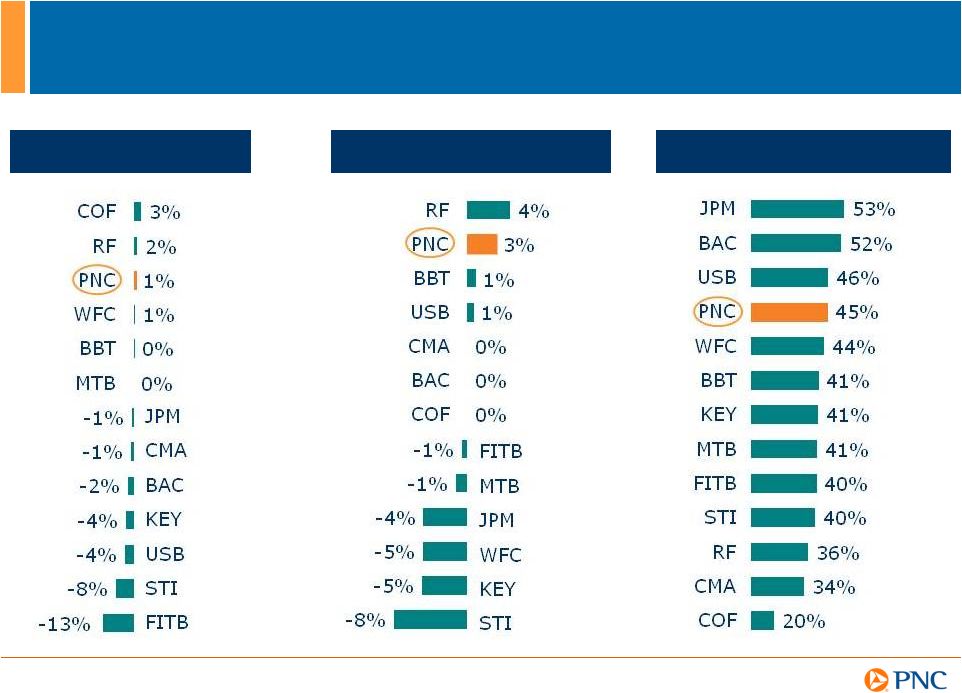 3Q14
Noninterest income as % of total revenue
2Q14-3Q14
Revenue growth
Linked Quarter Revenue Growth Driven by Higher
Noninterest Income
2Q14-3Q14
Noninterest income growth
5 |
 % Chg From
All Time High (3)
Variance
(1)
Performance Through the Cycle
Tangible Book Value
Per Common Share
(2)
All Time High
(3)
Closing
Stock Price vs. 10/28/14
Basel I Tier 1 Common
Capital Ratios
(1)
Performance
through the cycle
Disciplined risk
management
culture
Diverse franchise
Strong capital
management
Strategies to
drive growth
Franchise
Differentiation
% Chg 12/31/07 to 6/30/14
(2)
6
(1)
Source:
The
Board
of
Governors
of
the
Federal
Reserve
System
Dodd-Frank
Act
Stress
Test
(DFAST),
March
2014:
Supervisory
Stress
Test
Methodology
and
Results,
March
2014
(as
corrected).
The
variance
reflects
the
difference
under
the
Federal
Reserve’s
supervisory
stress
test
between
the
Basel
I
Tier
1
common
capital
ratios
reported
as
of
September
30,
2013
and
the
minimum
Basel
I
Tier
1
common
capital
ratio
projected
under
the
supervisory
severely
adverse
scenario
between
the
periods
4Q13
and
4Q15.
Ratios
were
calculated
using
the
capital
action
assumptions
contained
in
the
Federal
Reserve’s
Dodd-Frank
stress
testing
rules.
(2)
Peer
source:
SNL
DataSource.
See
Note
A,
Note
B
and
PNC
reconciliation
in
Appendix
for
further
details.
(3)
See
Note
C
in
Appendix
for
further
details. |
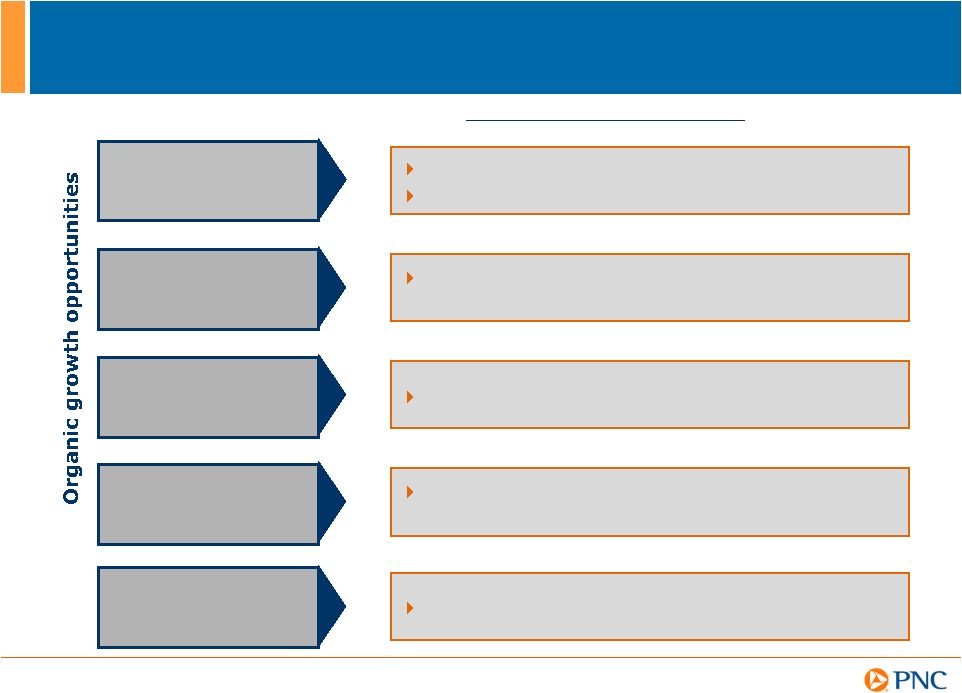 Southeast
sales
(1)
+20% CAGR (’12 -’14)
Midwest sales
(2)
+8% CAGR (’09 -’14)
Drive growth in
acquired &
underpenetrated
markets
Capture more
investable assets
Redefine the Retail
Banking business
Build a stronger
Residential Mortgage
business
Bolster infrastructure &
streamline processes
Executing Our Strategic Priorities
Strategic Priorities Update
Total client investment assets
(3)
:$302B +9%
(9/30/14 vs. 9/30/13)
Executing according to plan
Increased % of Purchase
(5)
originations to 50%
of total originations in 3Q14
Fee income
(4)
+7% (YTD14 vs. YTD13)
7
(1)
Southeast
markets
defined
as
Alabama,
Georgia,
North
Carolina,
South
Carolina
and
Florida.
Sales
for
total
Corporate
Banking
and
AMG.
AMG
refers
to
Asset
Management
Group.
2014
annualized.
(2)
Sales
for
total
Corporate
Banking
and
AMG.
2014
annualized.
(3)
Total
client
assets
includes
both
AMG
client
assets
under
administration
and
brokerage
account
client
assets
from
Retail
Banking
Brokerage
business.
(4)
Retail
Banking
fee
income
refers
to
noninterest
income
in
the
following
categories:
service
charges
on
deposits,
brokerage,
and
consumer
services.
YTD
results
for
the
nine
months
ended
September
2014
and
2013.
See
Reconcilement
in
Appendix.
(5)
A
mortgage
with
a
borrower
as
part
of
a
residential
real
estate
purchase
transaction. |
 Capturing
Long-Term Growth Potential in Attractive Southeast Markets
(1)
Source:
YouGov
syndicated
brand
data,
September
2014.
(2)
New
primary
clients
reflect
the
combined
growth
of
Corporate
Banking
and
AMG.
Corporate
Banking
primary client is defined as a corporate banking relationship with annual revenue generation of
$50,000 or more or, within Corporate Banking, a commercial banking client
relationship
with
annual
revenue
generation
of
$10,000
or
more.
Asset
Management
Group
(AMG)
primary
client
is
defined
as
a
client
relationship
with
annual
revenue generation of $10,000 or more. (3) Includes impact of RBC Bank (USA), which we acquired
on March 2, 2012. (5)
Alabama
Georgia
Florida
South Carolina
North Carolina
Southeast Highlights
Growth continues to outpace our
expectations
Teams and positions established with more
than 80% of our 6,000 employees focused
on customer interactions
Brand awareness increased to 65% in 3Q14
up from 50% in early 2013
(1)
New primary clients
(2)
for the nine months
ended September 30
2014 grew 29%
annually from the same period in 2012
(3)
Average loans grew 16% for the nine
months ended September 30 2014 from
the same period in 2012
(3)
and more than 2x
the growth in legacy markets
C&IB cross-sales percentages at their
highest levels since conversion
Branch network optimization included 69
consolidations and over 200 new ATM
locations since conversion
8
th
th |
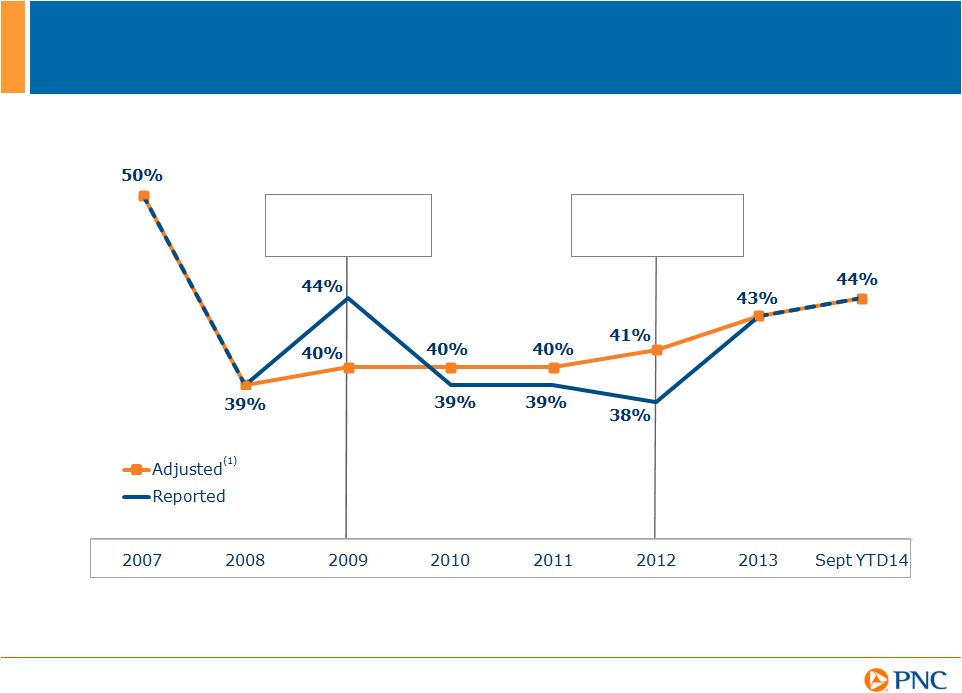 RBC Bank
(USA) Acquisition
As of March 2, 2012
Expanding Our Fee-Based Businesses
NCC
Acquisition
As of Dec. 31, 2008
9
Noninterest Income as a % of Total Revenue
for year ended December 31, except as noted
(1) Total revenue and noninterest income exclude pre-tax gain of $1.076 billion related to
BlackRock’s acquisition of Barclays Global Investors on December 1, 2009, and
benefit/(provision) related to residential mortgage repurchase obligations, as applicable. See reconcilement in Appendix for
additional details. |
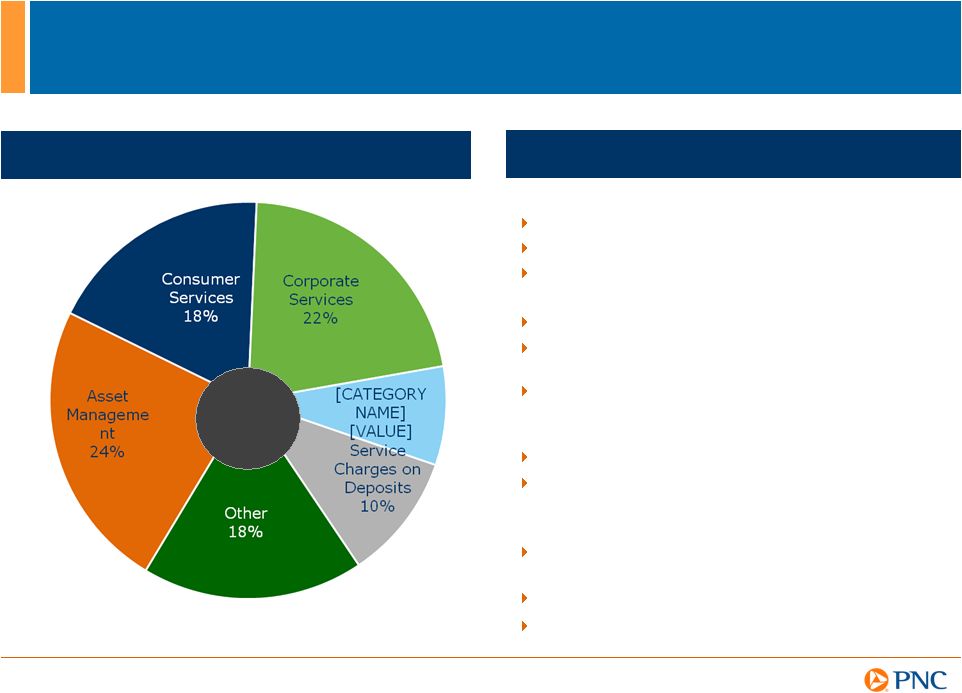 Diverse
Businesses Driving Fee Income Growth (1)
3Q14 Noninterest Income Mix
$1.7
billion
(2)
(4)
(3)
Strategies to drive higher fee income
across our franchise
Retail Banking
Increase share of wallet
Focus on product value for customers
Invest and grow mass affluent segment
Corporate & Institutional Banking
Leverage key franchises such as Harris Williams
Pursue cross-sell opportunities with recently
acquired clients
Deepen relationships via cross-sell with new
clients won during crisis
Asset Management Group
Leverage our referral channels
Capitalize on growth markets and Southeast
opportunities
Residential Mortgage Banking
Increase penetration of existing Retail Banking
households
Invest in purchase production
Selectively acquire Mortgage Servicing Rights
(MSR’s)
10
(1) See Appendix for fee income reconciliation. (2) Includes net commercial mortgage servicing
rights valuation gains. (3) Includes benefit/provision for residential
mortgage repurchase obligations. (4) Other includes net gains on sales of securities, net other-than-temporary impairments and other income.
Other income includes gain on sale of a portion of VISA class B common shares and credit
valuations for customer-related derivatives activities. |
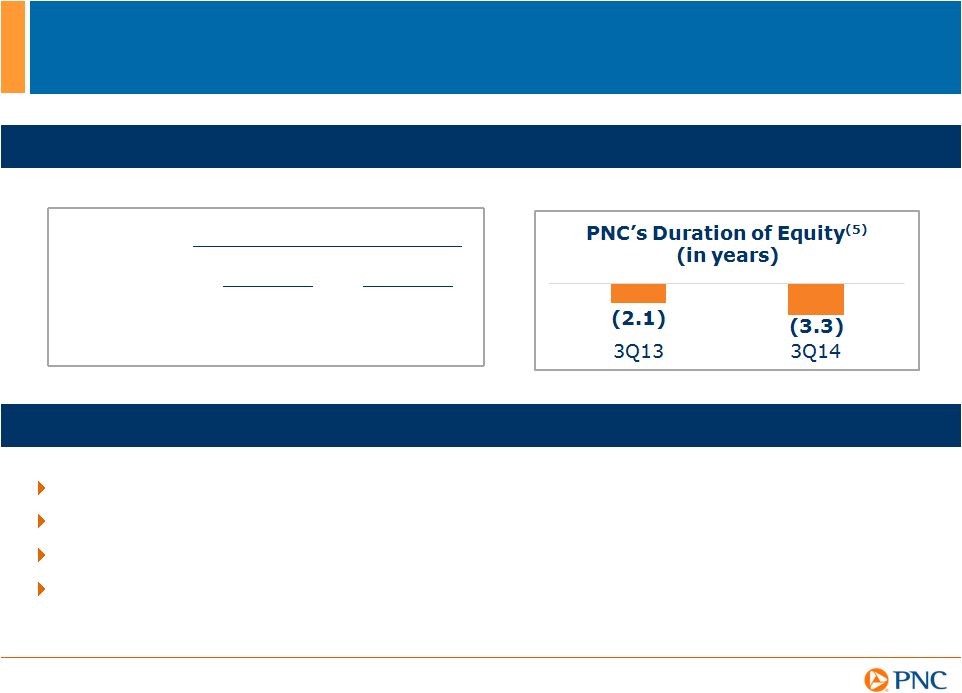 Year 1
(3)
Year 2
(4)
3Q14 10-Q
(1)
2.8%
7.0%
Balance Sheet Positioned for Rising Rates
Strategies
Grow loans within our risk appetite
Enhance our short-term liquidity position
Maintain investment securities portfolio flexibility
Maintain strong capital position
Net Interest Income Sensitivity
3Q14
(2)
100 Bps Parallel Increase
(1)
To
be
disclosed
in
forthcoming
3Q14
10-Q.
(2)
Third
Quarter
2014
Sensitivity
Simulation
reflects
the
interest
rate
risk
exposure
on
PNC’s
net
interest
income
(NII).
See
PNC’s
2013
10-K
and
2014
10-Qs
for
further
details
on
interest
rate
exposure
and
sensitivity.
(3)
Reflects
the
percentage
change
in
net
interest
income
in
first
year
as
a
result
of
gradual
100
bps
interest
rate
increase
over
following
twelve
months.
(4)
Reflects
the
percentage
change
in
net
interest
income
in
second
year
as
a
result
of
gradual
100bps
interest
rate
increase
over
preceding
twelve
months.
(5)
Reflects
base
case
model.
Given
the
inherent
limitations
in
certain
of
these
measurement
tools
and
techniques,
results
become
less
meaningful
as
interest
rates
approach
zero.
(1)
11 |
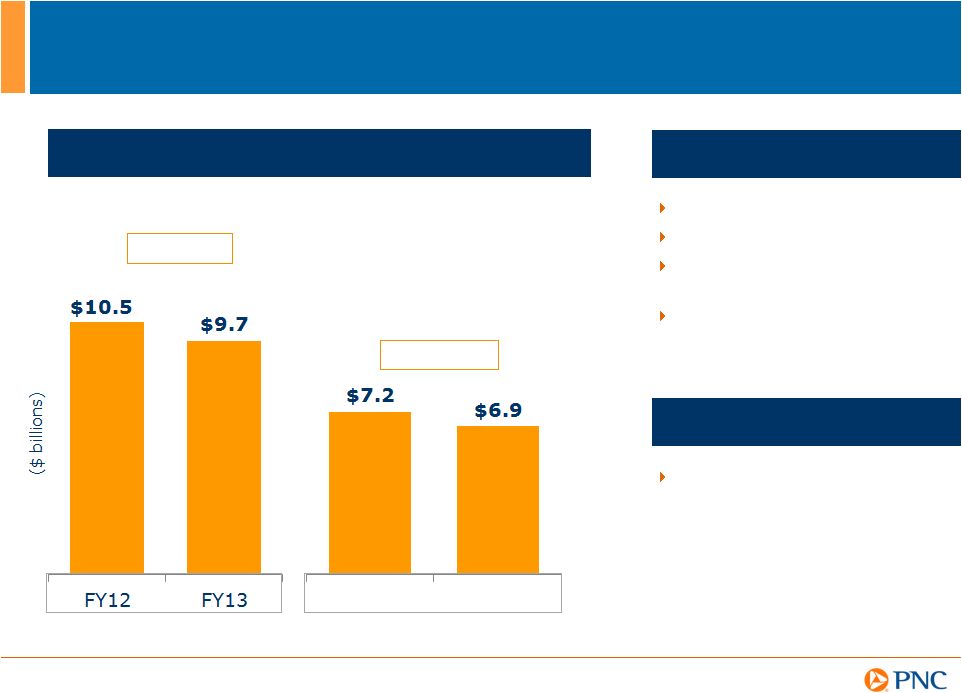 Focused
Expense Management While Investing for Future Growth
Branch reconfiguration
Process optimization
Re-engineering mortgage
servicing business
Completed actions to achieve
full year 2014 CIP
(2)
target of
$500 million ahead of schedule
Down 3%
Managing
Noninterest
Expense
(1)
2014 Expense Management
Opportunities
(1)
Prior
period
amounts
have
been
updated
to
reflect
the
first
quarter
2014
adoption
of
Accounting
Standards
Update
(ASU)
2014-01
related to investments in low income housing tax credits. (2) CIP refers to PNC’s
Continuous Improvement Program. Investing for Future Growth
Ongoing CIP
(2)
initiatives
including cost savings from
additional efficiencies should
help fund future investments
–
Infrastructure
–
Product and technology
–
Underpenetrated markets
Down 8%
Sept YTD13
Sept YTD14
12 |
 Stronger
Capital Position Capital Position Provides Capital Flexibility
Highlights
Capital priorities:
–
Build capital to support
client growth and business
investment
–
Maintain appropriate
capital in light of economic
uncertainty
–
Return excess capital to
shareholders, subject to
the CCAR process
Announced quarterly common
stock dividend of $0.48 for
3Q14
Repurchased 4.2 million
common shares for $360
million in 3Q14 under our
capital plan authorization
(5)
Payout Ratio
(4)
23%
45%
59%
13
(1) September 30, 2014 ratio estimated. (2) We previously referred to Basel III common equity
Tier 1 capital ratio as the Basel III Tier 1 common capital ratio. (3) Calculated on a pro forma basis without the benefit of the
Basel III phase-in provisions. For 4Q13, 1Q14, 2Q14 and 3Q14, the resulting pro forma fully
phased-in Basel III common equity Tier 1 ratios were calculated based on the standardized approach RWAs and rules. Advanced
approaches RWAs and rules were utilized for 3Q13. See Estimated Transitional Basel III and Pro
forma Fully Phased-In Basel III Common Equity Tier 1 Capital Ratios and related information in the Appendix for further details
(4) Payout ratio refers to amount used to fund common stock dividends and share repurchases as
a percentage of net income. (5) Repurchased under our 2014 capital plan authorization of up to $1.5 billion of common stock
for four quarter period through 1Q15. Ability to purchase full amount is subject to factors
such as market and general economic conditions, economic capital and regulatory capital conditions, alternative uses of capital,
regulatory and contractual limitations, issuances related to employee benefit plans and the
potential impact on credit ratings. |
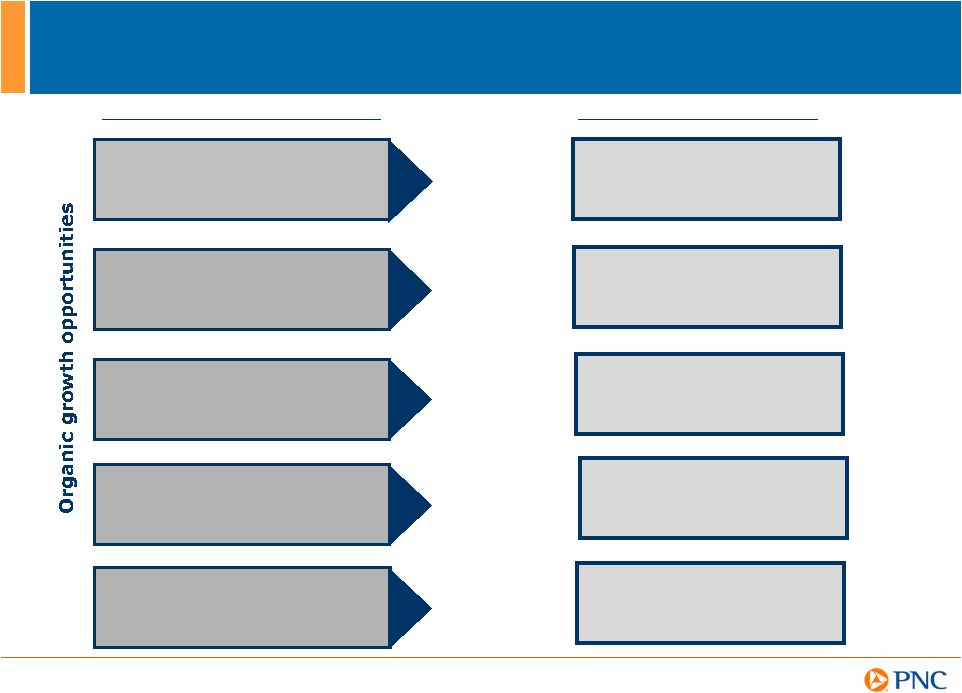 Strategies to
Drive Long-Term Potential Strategic Priorities Update
Long-Term
Potential
(1)
Incremental annual
revenue of $500M
Total client
investment assets
growth of $100 billion+
Fee income
(2)
growth of
mid to upper single digits
Increase product
penetration to
8%-10%
(3)
Scalable
Drive growth in acquired &
underpenetrated markets
Capture more investable assets
Redefine the Retail Banking
business
Build a stronger Residential
Mortgage business
Bolster infrastructure &
streamline processes
(1)
Refer
to
Cautionary
Statement
in
Appendix,
including
economic
and
other
assumptions.
Does
not
take
into
account
the
impact
of
potential
legal
and
regulatory
contingencies.
(2)
Retail
Banking
fee
income
refers
to
noninterest
income
in
the
following
categories:
service
charges
on
deposits,
brokerage,
and
consumer
services.
(3)
Residential
Mortgage
product
penetration
based
on
cross-sales
to
existing
Retail
Banking
households
with
current
penetration
of
6%.
14 |
 Well-Positioned for the Future
Opportunity to grow share in underpenetrated markets
and deepen product penetration
Focused on growing fee income businesses
Creating opportunities to drive positive operating
leverage
Stronger capital provides opportunity to return more
capital to shareholders
15 |
 Cautionary
Statement Regarding Forward-Looking Information
Appendix
This presentation includes “snapshot” information about PNC used by way of
illustration and is not intended as a full business or financial review. It should not
be viewed in isolation but rather in the context of all of the information made available by
PNC in its SEC filings. We also make statements in this presentation, and we may from time to time make
other statements, regarding our outlook for earnings, revenues, expenses, capital and
liquidity levels and ratios, asset levels, asset quality, financial position, and other matters regarding or affecting PNC and its future business and
operations that are forward-looking statements within the meaning of the Private
Securities Litigation Reform Act. Forward-looking statements are typically
identified by words such as “believe,” “plan,” “expect,”
“anticipate,” “see,” “look,” “intend,” “outlook,” “project,” “forecast,” “estimate,” “goal,” “will,” “should”
and other similar words and expressions.
Forward-looking statements are subject to numerous assumptions, risks and uncertainties,
which change over time. Forward-looking statements speak only as of the date made.
We do not assume any duty and do not undertake to update forward-looking statements. Actual results or future events could differ, possibly
materially, from those anticipated in forward-looking statements, as well as from
historical performance. Our forward-looking statements are subject to the following principal risks
and uncertainties. •
Our businesses, financial results and balance sheet values are affected by business and
economic conditions, including the following: –
Changes in interest rates and valuations in debt, equity and other financial markets. –
Disruptions in the liquidity and other functioning of U.S. and global financial markets. –
The impact on financial markets and the economy of any changes in the credit ratings of U.S.
Treasury obligations and other U.S. government- backed debt, as well as issues
surrounding the levels of U.S. and European government debt and concerns regarding the creditworthiness of
certain sovereign governments, supranationals and financial institutions in Europe. –
Actions by the Federal Reserve, U.S. Treasury and other government agencies, including those
that impact money supply and market interest rates.
–
Changes in customers’, suppliers’ and other counterparties’ performance and
creditworthiness. –
Slowing or reversal of the current U.S. economic expansion.
–
Continued residual effects of recessionary conditions and uneven spread of positive impacts
of recovery on the economy and our counterparties, including adverse impacts on levels
of unemployment, loan utilization rates, delinquencies, defaults and counterparty ability to meet credit and
other obligations.
–
Changes in customer preferences and behavior, whether due to changing business and economic
conditions, legislative and regulatory initiatives, or other factors. •
Our forward-looking financial statements are subject to the risk that economic and
financial market conditions will be substantially different than we are currently
expecting. These statements are based on our current view that the U.S. economic expansion will speed up to an above trend growth rate near
3.0 percent in the second half of 2014 and that short-term interest rates will remain very
low and bond yields will rise only slowly in the latter half of 2014. These
forward-looking statements also do not, unless otherwise indicated, take into account the impact of potential legal and regulatory
contingencies.
16 |
 Cautionary
Statement Regarding Forward-Looking Information
(continued) Appendix
•
PNC’s ability to take certain capital actions, including paying dividends and any plans
to increase common stock dividends, repurchase common stock under current or future
programs, or issue or redeem preferred stock or other regulatory capital instruments, is subject
to the review of such proposed actions by the Federal Reserve as part of PNC’s
comprehensive capital plan for the applicable period in connection with the
regulators’ Comprehensive Capital Analysis and Review (CCAR) process and to the acceptance of such capital plan
and non-objection to such capital actions by the Federal Reserve. • PNC’s regulatory capital ratios in the future will depend on,
among other things, the company’s financial performance, the scope and terms of
final capital regulations then in effect (particularly those implementing the Basel Capital Accords), and management actions
affecting the composition of PNC’s balance sheet. In addition, PNC’s ability to
determine, evaluate and forecast regulatory capital ratios, and to take actions (such as
capital distributions) based on actual or forecasted capital ratios, will be dependent at least in part on the
development, validation and regulatory approval of related models.
•
Legal and regulatory developments could have an impact on our ability to operate our
businesses, financial condition, results of operations, competitive position,
reputation, or pursuit of attractive acquisition opportunities. Reputational impacts could affect matters
such as business generation and retention, liquidity, funding, and ability to attract and
retain management. These developments could include: –
Changes resulting from legislative and regulatory reforms, including major reform of the
regulatory oversight structure of the financial services industry and changes to laws
and regulations involving tax, pension, bankruptcy, consumer protection, and other
industry aspects, and changes in accounting policies and principles. We will be impacted by extensive reforms provided for
in the Dodd-Frank Wall Street Reform and Consumer Protection Act (the
“Dodd-Frank Act”) and otherwise growing out of the most recent financial
crisis, the precise nature, extent and timing of which, and their impact on us, remains uncertain.
–
Changes to regulations governing bank capital and liquidity standards, including due to the
Dodd-Frank Act and to Basel-related initiatives. –
Unfavorable resolution of legal proceedings or other claims and regulatory and other
governmental investigations or other inquiries. In addition to matters relating to
PNC’s current and historical business and activities, such matters may include
proceedings, claims, investigations, or inquiries relating to pre-acquisition business
and activities of acquired companies, such as National City. These matters may result
in monetary judgments or settlements or other remedies, including fines, penalties,
restitution or alterations in our business practices, and in additional expenses and
collateral costs, and may cause reputational harm to PNC. –
Results of the regulatory examination and supervision process, including our failure to
satisfy requirements of agreements with governmental agencies. –
Impact on business and operating results of any costs associated with obtaining rights in
intellectual property claimed by others and of adequacy of our intellectual property
protection in general.
17 |
 Cautionary
Statement Regarding Forward-Looking Information
(continued) Appendix
Business and operating results are affected by our ability to identify and effectively manage
risks inherent in our businesses, including, where appropriate, through effective use
of third-party insurance, derivatives, and capital management techniques, and to meet
evolving regulatory capital and liquidity standards. In particular, our results currently
depend on our ability to manage elevated levels of impaired assets.
Business and operating results also include impacts relating to our equity interest in
BlackRock, Inc. and rely to a significant extent on information provided to us by
BlackRock. Risks and uncertainties that could affect BlackRock are discussed in more detail by BlackRock
in its SEC filings.
We grow our business in part by acquiring from time to time other financial services
companies, financial services assets and related deposits and other liabilities.
Acquisition risks and uncertainties include those presented by the nature of the business acquired,
including in some cases those associated with our entry into new businesses or new geographic
or other markets and risks resulting from our inexperience in those new areas, as well
as risks and uncertainties related to the acquisition transactions themselves,
regulatory issues, and the integration of the acquired businesses into PNC after closing. Competition can have an impact on customer acquisition, growth and retention and on credit
spreads and product pricing, which can affect market share, deposits and revenues.
Industry restructuring in the current environment could also impact our business and
financial performance through changes in counterparty creditworthiness and performance and in
the competitive and regulatory landscape. Our ability to anticipate and respond to
technological changes can also impact our ability to respond to customer needs and meet
competitive demands. Business and operating results can also be affected by widespread natural and other disasters,
pandemics, dislocations, terrorist activities, cyberattacks or international
hostilities through impacts on the economy and financial markets generally or on us or our
counterparties specifically.
We provide greater detail regarding these as well as other factors in our 2013 Form 10-K
and our 2014 Form 10-Qs, including in the Risk Factors and Risk Management sections
and the Legal Proceedings and Commitments and Guarantees Notes of the Notes To Consolidated
Financial Statements in those reports, and in our subsequent SEC filings. Our
forward-looking statements may also be subject to other risks and uncertainties,
including those we may discuss elsewhere in this presentation or in our SEC filings, accessible on the SEC’s website at
www.sec.gov and on our corporate website at www.pnc.com/secfilings. We have included these web
addresses as inactive textual references only. Information on these websites is not
part of this document. Any annualized, pro forma, estimated, third party or consensus numbers in this
presentation are used for illustrative or comparative purposes only and may not reflect
actual results. Any consensus earnings estimates are calculated based on the earnings projections made by analysts
who cover that company. The analysts’ opinions, estimates or forecasts (and therefore the
consensus earnings estimates) are theirs alone, are not those of PNC or its management,
and may not reflect PNC’s or other company’s actual or anticipated results.
18 |
 Notes
Appendix
Explanatory Notes
(A) Tangible book value (TBV) per common share calculated based on tangible common
shareholders' equity (common shareholders' equity less goodwill and other intangible
assets, other than servicing rights, net of deferred tax liabilities on such intangible
assets) divided by period-end common shares outstanding. Peer source: SNL Datasource and company
filings. See Appendix for PNC reconciliation.
(B) Tangible book value 12/31/2007 PNC data has not been updated to reflect PNC's first
quarter 2014 adoption of Accounting Standards Update (ASU) 2014-01 related to
investments in low income housing credits. (C) All time high percent change reflects the
difference between the all time high closing stock price using the highest closing
price since 12/31/1989 as reported by SNL DataSource and the 10/28/2014 closing price.
19 |
 Estimated
Transitional Basel III and Pro forma Fully Phased-In Basel III Common Equity Tier 1
Capital Ratios Appendix
As a result of the staggered effective dates of the final U.S. capital rules issued in July
2013, as well as the fact that PNC remains in the parallel run qualification phase for
the advanced approaches, PNC’s regulatory risk-based capital ratios during
2014 are based on the definitions of, and deductions from, capital under Basel III (as
such definitions and deductions are phased-in for 2014) and Basel I risk-weighted assets (but subject
to certain adjustments as defined by the Basel III rules). We refer to the capital ratios
calculated using these Basel III phased-in provisions and Basel I risk-weighted
assets as the Transitional Basel III ratios. These capital ratios became effective for
PNC on January 1, 2014. We provide information on the next slide regarding PNC’s
estimated Transitional Basel III common equity Tier 1 ratio and PNC’s estimated
pro forma fully phased-in Basel III common equity Tier 1 ratio. We previously
referred to the Basel III common equity Tier 1 ratio as the Basel III Tier 1 common
ratio. In addition, on the next slide we provide information regarding PNC’s Basel I Tier 1
common capital ratio during 2013, which was applicable to PNC through 2013 under the U.S.
regulatory capital rules.
Common equity Tier 1 capital as defined under the Basel III rules adopted by the U.S. banking
agencies differs materially from Basel I Tier 1 common capital. For example, under
Basel III, significant common stock investments in unconsolidated financial
institutions, mortgage servicing rights and deferred tax assets must be deducted from
capital to the extent they individually exceed 10%, or in the aggregate exceed 15%, of
the institution’s adjusted common equity Tier 1 capital. Also, Basel I regulatory
capital excludes accumulated other comprehensive income related to securities
currently and previously held as available for sale, as well as pension and other
postretirement plans, whereas under Basel III these items are a component of PNC's
capital. 20 |
 Estimated
Transitional Basel III and Pro forma Fully Phased-In Basel III Common Equity Tier 1
Capital Ratios Appendix
21
Transitional Basel III
Pro forma Fully Phased-In Basel III
Dollars in millions
Sept. 30, 2014
Jun. 30, 2014
Mar. 31, 2014
Sept. 30, 2014
Jun. 30, 2014
Mar. 31, 2014
Dec. 31, 2013(a)
Sept. 30, 2013(a)
Common stock, related surplus, and retained earnings, net of
treasury stock
$39,808
$39,380
$38,722
$39,808
$39,380
$38,722
$38,031
$37,143
Less regulatory capital adjustments:
Goodwill and disallowed intangibles, net of deferred tax liabilities
(8,914)
(8,923)
(8,932)
(9,234)
(9,262)
(9,291)
(9,321)
(9,350)
Basel III total threshold deductions
(214)
(216)
(214)
(1,067)
(1,075)
(1,186)
(1,386)
(2,011)
Accumulated other comprehensive income (b)
100
115
82
501
576
410
196
(231)
All other adjustments (c)
(28)
(5)
(16)
(93)
(74)
(106)
(64)
(302)
Estimated Basel III Common equity Tier 1 capital
30,752
$
30,351
$
29,642
$
29,915
$
29,545
$
28,549
$
27,456
$
25,249
$
Estimated Basel I risk-weighted assets calculated in accordance
with transition rules for 2014 (d)
277,348
$
277,126
$
273,826
$
N/A
N/A
N/A
N/A
N/A
Estimated Basel III standardized approach risk-weighted assets (e)
N/A
N/A
N/A
295,665
$
295,217
$
293,310
$
291,977
$
N/A
Estimated Basel III advanced approaches risk-weighted assets (f)
N/A
N/A
N/A
289,405
$
290,063
$
289,441
$
290,080
$
289,063
$
Estimated Basel III Common equity Tier 1 capital ratio
11.1%
11.0%
10.8%
10.1%
10.0%
9.7%
9.4%
8.7%
Risk-weight and associated rules utilized
Basel I (with
2014 transition
adjustments)
Basel I (with
2014 transition
adjustments)
Basel I (with
2014 transition
adjustments)
Standardized
Standardized
Standardized
Standardized
Advanced
(a) Amounts have not been updated to reflect the first quarter 2014 adoption of ASU 2014-01
related to investments in low income housing tax credits. (b) Represents net adjustments
related to accumulated other comprehensive income for securities currently and previously held as
available for sale, as well as
pension and other postretirement plans.
(c) Includes adjustments as required based on whether the standardized approach or advanced
approaches is utilized. (d) Includes credit and market risk-weighted assets.
(e) Basel III standardized approach risk-weighted assets were estimated based on the Basel
III standardized approach rules and include credit and market risk-weighted assets.
(f) Basel III advanced approaches risk-weighted assets were estimated based on the Basel
III advanced approaches rules, and include credit, market and operational risk-weighted assets.
2013 Basel I Tier 1 Common Capital Ratio (a) (b)
Dollars in millions
Dec. 31, 2013
Sept. 30, 2013
Basel I Tier 1 common capital
$28,484
$27,540
Basel I risk-weighted assets
272,169
266,698
Basel I Tier 1 common capital ratio
10.5%
10.3%
(a) Effective January 1, 2014, the Basel I Tier 1 common capital
ratio no longer applies to PNC (except for stress testing purposes). Our
2013 Form 10-K included additional information regarding our Basel I capital ratios.
PNC utilizes the pro forma fully phased-in Basel III capital ratios to assess its capital
position (without the benefit of phase-ins), including comparison to similar estimates made by other financial institutions.
Our Basel III capital ratios and estimates may be impacted by additional regulatory guidance or
analysis, and in the case of those ratios calculated using the advanced approaches, the ongoing evolution,
validation and regulatory approval of PNC’s models integral to the calculation of advanced
approaches risk-weighted assets. (b) Amounts have not been updated to reflect the
first quarter 2014 adoption of ASU 2014-01 related to investments in low income housing
tax credits. |
 Tangible Book
Value per Common Share Appendix
Tangible Book Value per Common Share Ratio
6/30/14 vs.
12/31/07
Dollars in millions, except per share data
June 30, 2014
Dec. 31, 2007
(a)
Book value per common share (a)
75.62
$
43.60
$
73%
Tangible book value per common share
Common shareholders' equity (a)
40,261
$
14,847
$
Goodwill and Other Intangible Assets (b)
(9,590)
(8,850)
Deferred tax liabilities on Goodwill and Other Intangible Assets (b)
327
119
Tangible common shareholders' equity
30,998
$
6,116
$
Period-end common shares outstanding (in millions)
532
341
Tangible book value per common share (Non-GAAP)
58.22
$
17.96
$
224%
(b) Excludes the impact from mortgage servicing rights of $1.5 billion at June 30, 2014 and
$.7 billion at December 31, 2007. Tangible book value per common share is a non-GAAP
financial measure and is calculated based on tangible common shareholders’ equity
divided by period-end common shares outstanding. We believe this non-GAAP financial measure serves as a useful tool to
help evaluate the strength and discipline of a company's capital management strategies and as
an additional, conservative measure of total company value.
(a) Amounts for the 2007 period have not been updated to reflect the first quarter 2014
adoption of Accounting Standards Update (ASU) 2014-01 related to investments in low
income housing tax credits. % Change
22 |
 Non-GAAP
to GAAP Reconcilement Appendix
$ in millions
September 30, 2013
September 30, 2014
% change
Service charges on deposits
$419
$461
Brokerage
$167
$176
Consumer services
$679
$714
Total Retail Banking fee income
$1,265
$1,351
7%
Other
$268
$240
$1,533
$1,591
4%
Total Retail Banking noninterest income, as reported
For
the nine months ended
For the three months ended
$ in millions
September 30, 2013
September 30, 2014
% change
September 30, 2013
September 30, 2014
% change
Asset management
$330
$411
$978
$1,137
Consumer services
$316
$320
$926
$933
Corporate services
$306
$374
$909
$1,018
Residential mortgage
$199
$140
$600
$483
Service charges on deposits
$156
$179
$439
$482
Total fee income
$1,307
$1,424
9%
$3,852
$4,053
5%
Net gains (losses) on sales of securities
$21
$0
$96
$4
Net other-than-temporary impairments
($2)
($1)
($16)
($4)
Other
$360
$314
$1,126
$947
Total noninterest income, as reported
$1,686
$1,737
3%
$5,058
$5,000
-1%
For
the nine months ended
23 |
 Non-GAAP
to GAAP Reconcilement Appendix
2007
2008
2009
2010
2011
2012
2013
Sept YTD14
Total revenue, as reported
5,891
$
6,296
$
16,228
$
15,176
$
14,326
$
15,512
$
16,012
$
11,428
$
Noninterest income, as reported
2,944
$
2,442
$
7,145
$
5,946
$
5,626
$
5,872
$
6,865
$
5,000
$
Noninterest income as % of total revenue
50%
39%
44%
39%
39%
38%
43%
44%
Total revenue, as reported
5,891
$
6,296
$
16,228
$
15,176
$
14,326
$
15,512
$
16,012
$
11,428
$
Pretax
gain
related
to
BlackRock's
acquisition
of
Barclays
Global
Investors
(BGI)
(1,076)
$
Pretax
benefit/(provision)
for
residential
mortgage
repurchase
obligations
73
$
96
$
66
$
761
$
(53)
$
(4)
$
Total revenue, as adjusted
5,891
$
6,296
$
15,225
$
15,272
$
14,392
$
16,273
$
15,959
$
11,424
$
Noninterest income, as reported
2,944
$
2,442
$
7,145
$
5,946
$
5,626
$
5,872
$
6,865
$
5,000
$
Pretax gain related to BlackRock's acquisition of BGI
(1,076)
$
Pretax
benefit/(provision)
for
residential
mortgage
repurchase
obligations
73
$
96
66
761
$
(53)
$
(4)
$
Noninterest income, as adjusted
2,944
$
2,442
$
6,142
$
6,042
$
5,692
$
6,633
$
6,812
$
4,996
$
Noninterest income, as adjusted as % of total revenue, as adjusted
50%
39%
40%
40%
40%
41%
43%
44%
24 |
 Peer Group of
Banks Appendix
The PNC Financial Services Group, Inc.
PNC
BB&T Corporation
BBT
Bank of America Corporation
BAC
Capital One Financial, Inc.
COF
Comerica Inc.
CMA
Fifth Third Bancorp
FITB
JPMorgan Chase
JPM
KeyCorp
KEY
M&T Bank
MTB
Regions Financial Corporation
RF
SunTrust Banks, Inc.
STI
U.S. Bancorp
USB
Wells Fargo & Co.
WFC
25 |
